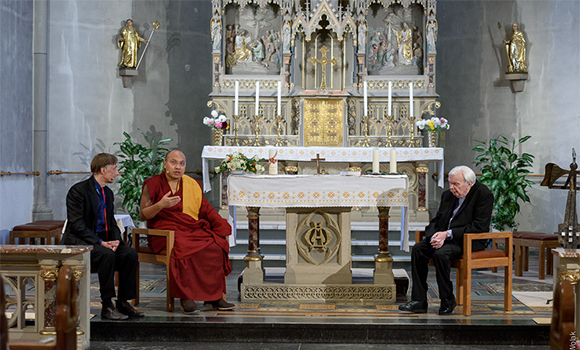
St. Quirinus, Langenfeld–1st September, 2015
On 30th August in the evening, the 17th Karmapa left Bonn and returned to the Kamalashila Institute in Langenfeld. The following evening he joined the villagers for a special event at the parish church of St. Quirinus. This was his second visit to Langenfeld parish church. He first visited the church in May 2014, and at that time promised the priest, Monsignore Schrupp, that he would return. As Monsignore Schrupp remarked in his welcome speech, “I did not expect him to come back so soon!” The event, organised jointly by Kamalashila Institute, the church of St. Quirinus and the people of Langenfeld, drew more than 500 people. There were no empty spaces in the pews.
This imposing church with its high vaulted ceiling, known as the ‘Dom’ or cathedral, was filled with the warmth exuded by the local people and their obvious delight that His Holiness had come to spend an evening with them.
The Karmapa and Monsignore Schrupp, walked into the church together like old friends, and when the monsignor bowed respectfully to the altar, the Karmapa followed suit, demonstrating his own deep respect for the Christian religious tradition.
The evening’s dialogue on the role of religion in the 21st century began with Monsignore Schrupp talking briefly about the difficulties world faiths face at a time when atrocities were committed in the name of religion and Western society was becoming increasingly secularised. He suggested that an important task for religious leaders was to help people reconnect with a spiritual path.
In his response, the Karmapa first explained the importance of religion in the Tibetan community in exile. When they escaped from Tibet, the people had been forced to leave everything behind. They came to India as refugees having lost everything, not just their belongings but also their homeland. In the face of this tragedy, many had developed a renewed devotion to their religion. Widening the scope, he suggested that it was of utmost importance that all religious traditions work together to spread the positive messages of religions to counteract the impact of the negative actions committed by some. Although there may be philosophical differences, he continued, there is a lot of common ground which religions share: “The main message seems to be the same for all religions: we are all human beings living on this planet, and we are all interested in avoiding suffering and being happy.” Religions share a message of unity and peace. Thus it is more important for them to focus on the ‘power of the heart’ rather than differences in dogma, he concluded.
The floor was now opened to questions from the congregation. The first asked about recent proposals by His Holiness the Dalai Lama for a secular ethic which could be of relevance worldwide. What were the Karmapa’s views on this? The Karmapa observed that the use of religious terms could be a barrier to communication. Consequently, it is sometimes more beneficial to use other ways to express the valuable and helpful ideas contained in religious traditions. “Each religion has a treasury of good qualities to offer, which are of practical help; for instance the quality of loving kindness, and also the patience which cannot be disturbed by anger.” In order to be able to help people in urgent need, he continued, “We have to transcend the borders and limits of our religious concepts.”
The second question concerned the role of women in Buddhism and whether there could ever be a female Karmapa. It seemed that nowadays most religious traditions have taken steps to strengthen the position of women, His Holiness replied, but society at large also plays a crucial role in this issue. Of course, it was possible for there to be a female Karmapa, he said, but it is contingent on the status of women in society changing.
“From the viewpoint of Buddha dharma, there are no obstacles to a female Karmapa, although so far this has not happened… it could happen if there were a change in society; it all comes down to whether the Karmapa can best perform his activities as a male or female…what is helpful for beings in society and how we can make a change.”
Moving on to the third question, His Holiness considered yet another important issue in Europe today. How is it possible to reach the hearts of terrorists?
“You teach that it is important to reach the hearts of people. However there seem to be people whose hearts we cannot reach, for instance Islamic State militants. Is there always a chance to reach people’s hearts?” the questioner asked.
The Karmapa acknowledged that even he found it very difficult to accept the attitudes and actions of people such as the members of the I.S. organisation, but suggested that we need to reflect on what has made them act in that way. Though it is difficult to be empathic with those who seem to enjoy killing indiscriminately, we need to remember that many of them have been brainwashed from an early age. ”If they now act in this hateful and violent way, it is the result of their nurture, which has deafened their own hearts and driven them into ignorance,” he maintained. “If we see them as beings trapped in ignorance, we may be able to view them with compassion and concern.” It was more difficult to understand those people who had grown up in Western society, who, because of various causes and conditions, had been corrupted and joined the terrorists. “We have to take into account their background and education,” he suggested. However, returning once more to the advice he gave during the teaching on the Buddha Akshobhya, His Holiness counselled, “We have to be careful not to act under the influence of our own instinctive reactions.”
Monsignore Schrupp had been listening attentively. He now interrupted to exclaim, “Isn’t it amazing… here we are, sitting in the Langenfeld church… two representatives of two different religious traditions…yet, when I listen to your answers, I realise they are exactly what I would have said…”
It seemed the dialogue had become a real-life demonstration of a heart connection between the views of two very different religious traditions. This led appropriately into the final question, posed by a woman who had been born and raised as a Catholic but had now become a Buddhist, and addressed to both Monsignore Schrupp and the Karmapa. Her question was nearer a heartfelt plea that religions should work together from their shared ground of love and compassion in order to ameliorate suffering. Was it not possible, she asked, to unite the potential of both sides in order to diminish suffering in the world?
The Karmapa answered first. In theory it is possible for religions to work together but it seems to be very difficult to put into practice. He drew on his own experiences at inter-faith dialogues in India.
The delegates espoused brotherhood in public, but later returned to their own peer groups, and the distance between them and others, and the arguments began again. The important thing, His Holiness suggested, is for religious leaders to meet in friendship, in a way similar to his meeting with Monsignore Schrupp, developing a heart-to-heart connection.
Monsignore Schrupp agreed that co-operation between different religious traditions is possible, and gave an analogy with medical care. ”When people are taken to hospital, no-one cares about what religion they are…they give them the medical care they need. With regards to this, there are many good things happening in practice but I don’t have the facts to hand,” he concluded.
On his instructions, the congregation lit the hundreds of candles which had been placed on the pews and sat silently as Monsignor Schrupp and the Karmapa stood in front of the altar and offered prayers from their respective traditions, for the well-being of all sentient beings and world peace. The evening finished with a Christian and a Buddhist benediction, and the audience broke into loud applause, obviously impressed by the Karmapa’s answers and the heart-to-heart connection between their elderly priest and the young Buddhist leader.
The Karmapa walked over to a side chapel, and there offered a kata [a white scarf traditionally offered by Tibetans as a sign of respect] to the statue of the Virgin Mary. Placing a lighted candle on the holder in front of her shrine, he stood for a moment in meditation. It was a perfect ending to an evening which had demonstrated that it is possible for different religious traditions to share ideas, hopes and difficulties in an atmosphere of mutual respect.


